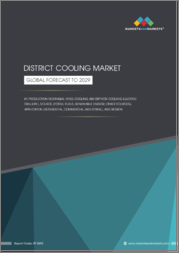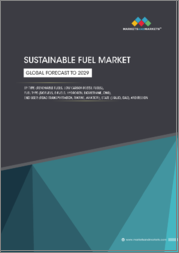
|
시장보고서
상품코드
1389871
세계의 화석연료 에너지 시장 : 연료 유형별(석탄, 석유, 천연가스), 최종사용자별(가정용, 상업용, 산업용, 기타), 지역별 평가, 기회 및 예측(2016-2030년)Fossil Fuel Energy Market Assessment, By Fuel Type [Coal, Oil, Natural Gas], By End-user [Residential, Commercial, Industrial, Others], By Region, Opportunities and Forecast, 2016-2030F |
||||||
세계 화석연료 에너지 시장 규모는 2022년 1조 5,560억 달러로 평가되었고, 예측 기간(2023-2030년) 동안 5.64%의 연평균 복합 성장률(CAGR)로 성장하여 2030년에는 2조 4,134억 4,400만 달러에 달할 것으로 예상됩니다. 보급률 증가, 높은 에너지 밀도, 광범위한 가용성, 잘 구축된 인프라 등 여러 가지 요인이 시장을 주도하고 있습니다. 화석 연료는 신뢰할 수 있고 비용 효율적인 에너지를 제공하여 세계 경제 성장에 크게 기여하고 있습니다. 또한 지정학적 영향과 특정 지역의 풍부한 화석연료 매장량도 시장 확대에 박차를 가하고 있습니다. 또한, 화석연료 에너지 산업은 채굴 공정의 효율성과 관련 비용 절감을 위한 첨단 기술의 채택이 증가하고 있으며, 이는 예측 기간 동안 시장에 큰 성장 기회를 제공할 것으로 예상됩니다.
화석연료의 채택은 기존 인프라, 에너지 밀도 및 경제적 이익으로 인해 계속 증가하고 있습니다. 잘 구축된 공급 시스템과 저렴한 가격으로 인해 화석 연료는 신뢰할 수 있는 선택이 되고 있습니다. 또한, 지정학적 요인과 일부 지역의 풍부한 매장량도 지속적인 성장을 가속하고 있습니다.
예를 들어, 환경에너지연구소(Environmental and Energy Study Institute, EESI)에 따르면, 석탄, 석유, 천연가스는 1세기 이상 세계 경제의 원동력이었으며, 현재 세계 에너지 수요의 약 80%를 공급하고 있습니다. 가장 탄소 집약적인 화석연료임에도 불구하고 석탄은 세계 발전량의 거의 3분의 1을 차지합니다.
본 보고서는 세계의 화석연료 에너지 시장에 대해 분석했으며, 제품 개요와 시장의 기본 구조, 전체 시장 규모 동향 전망, 부문별/지역별 상세 동향, 시장 배경과 주요 영향요인, 주요 기업 개요와 시장 점유율 등의 정보를 조사하여 전해드립니다.
목차
제1장 조사 방법
제2장 프로젝트의 범위와 정의
제3장 신형 코로나바이러스(COVID-19)가 세계의 화석연료 에너지 시장에 미치는 영향
제4장 러시아·우크라이나 전쟁의 영향
제5장 주요 요약
제6장 고객의 견해
- 제품 및 시장 정보
- 구입 의사결정시에 고려되는 요소
제7장 세계의 화석연료 에너지 시장 전망(2016년-2030년)
- 시장 규모와 예측
- 금액 기준
- 연료 유형별
- 석탄
- 석유
- 천연가스
- 최종사용자별
- 가정용
- 상업용
- 산업용
- 기타
- 지역별
- 북미
- 유럽
- 남미
- 아시아태평양
- 중동 및 아프리카
- 기업별 시장 점유율(%, 2022년)
제8장 세계의 화석연료 에너지 시장 전망 : 지역별(2016년-2030년)
- 북미
- 시장 규모와 예측
- 금액 기준
- 연료 유형별
- 최종사용자별
- 미국
- 시장 규모와 예측
- 연료 유형별
- 최종사용자별
- 캐나다
- 멕시코
- 시장 규모와 예측
각 부문의 정보는 대상이 되는 모든 지역과 국가에 대해 제공됩니다.
- 유럽
- 독일
- 프랑스
- 이탈리아
- 영국
- 러시아
- 네덜란드
- 스페인
- 남미
- 브라질
- 아르헨티나
- 아시아태평양
- 인도
- 중국
- 일본
- 호주
- 한국
- 중동 및 아프리카
- 사우디아라비아
- 아랍에미리트(UAE)
- 남아프리카공화국
제9장 시장 매핑(2022년)
- 연료 유형별
- 최종사용자별
- 지역별
제10장 거시환경과 산업 구조
- 수급 분석
- 수출입 분석
- 밸류체인 분석
- PESTEL 분석
- Porter의 Five Forces 분석
제11장 시장 역학
- 성장 촉진요인
- 성장 억제요인(과제, 제약)
제12장 주요 기업 상황
- 시장 리더 주요 5개사 : 경쟁 매트릭스
- 시장 리더 주요 5개사 : 시장 매출 분석(%, 2022년)
- 기업인수합병(M&A)/합작투자(해당하는 경우)
- SWOT 분석(시장 진출기업 5개사의 경우)
- 특허 분석(해당하는 경우)
제13장 가격 분석
제14장 사례 연구
제15장 주요 기업 전망
- Engie SA
- 기업 개요
- 경영 임원
- 제품 및 서비스
- 재무 상황(보고된 대로)
- 중점 시장과 지역 존재감
- 최근 동향
- AGL Energy Limited
- Energy Australia Holdings Limited
- Enel SpA
- ABB Ltd.
- Coal India Ltd.
- Origin Energy Limited
- State Power Investment Corporation Limited
- Iberdrola
- Saudi Arabian Oil Company(Saudi Aramco)
- Chevron Corporation
상기 기업은 시장 점유율 순서가 아니며, 조사 작업 중에 입수한 정보에 따라서 변경될 가능성이 있습니다.
제16장 전략 제안
제17장 Market Xcel에 대해/면책사항
LSH 23.12.12Global Fossil Fuel Energy market size was valued at USD 1556 billion in 2022, expected to reach USD 2413.44 billion in 2030, with a CAGR of 5.64% for the forecast period between 2023 and 2030. Several factors, including a rising adoption rate, high energy density, widespread availability, and a well-established infrastructure drive the market. Fossil fuels provide reliable and cost-effective energy and have a major contribution towards overall economic growth across the globe. Moreover, geopolitical influences and the abundance of fossil fuel reserves in certain regions also fuel their expansion. Furthermore, the increasing adoption of cutting-edge technologies in the fossil fuel energy industry to improve the efficiency of the extraction process and reduce the associated costs is expected to create huge growth opportunities for the market over the forecasted period.
Fossil fuel adoption continues to rise due to existing infrastructure, energy density, and economic interests. Their well-established delivery systems and affordability make them a reliable choice. Additionally, geopolitical factors and abundant reserves in some regions augment their continued growth.
For example, according to the Environmental and Energy Study Institute (EESI), coal, oil, and natural gas have been the driving force behind the global economy for more than a century, and currently, they provide approximately 80% of the world's energy needs. Despite being the most carbon-intensive fossil fuel, coal is used for nearly one-third of global electricity generation.
Surging Methane Demand Fuels Growth in Fossil Fuel Energy Sector Amid Global Shift Towards Cleaner Alternatives
The growing appetite for methane gas is propelling the fossil fuel energy market forward. Methane, a crucial element of natural gas, is one of the most efficient natural gases for power generation, heating, and various industrial applications. This heightened demand plays a significant role in the expansion of the fossil fuel sector as the global community seeks cleaner energy alternatives to address environmental concerns and confront the challenges of climate change.
For example, in 2022, the global energy industry alone was responsible for approximately 135 million metric tons of methane emissions. This sector constitutes nearly 40% of the total methane emissions attributed to human activities, securing its position as the second-largest contributor in terms of emission magnitude, with agriculture being the sole sector ahead.
Fossil Fuel Market Witnesses Substantial Growth Amid Versatile Industrial Applications, Prompting a Need for Sustainable Alternatives
The fossil fuel market is experiencing substantial growth due to the widespread use of fossil fuels in various industrial applications. Fossil fuels remain a crucial energy source for numerous sectors, with their versatile applications contributing to sustained market growth. However, it's essential to consider the various environmental implications and explore cleaner, sustainable alternatives to mitigate the environmental impact of fossil fuel consumption.
For example, as per Energy Information Administration (EIA), in 2022, the United States generated approximately 4.23 trillion kilowatt-hours (kWh) of electricity at utility-scale facilities, with nearly 60% of this electricity derived from fossil fuels. Furthermore, the country consumed an average of 8.78 million barrels per day (369 million gallons per day) of finished motor gasoline, representing around 43% of total United States petroleum consumption.
Persistent Investments in Fossil Fuel Infrastructure: Navigating Market Opportunities Amidst Global Energy Transition
Investments in fossil fuel infrastructure persist, presenting significant market opportunities. Despite a global shift toward renewable energy, fossil fuels remain essential for meeting energy demands. These investments contribute to maintaining and expanding the necessary infrastructure for extracting, processing, and distributing fossil fuels, ensuring a reliable energy supply. Capitalizing on these opportunities supports economic growth in regions abundant in fossil fuel resources, even amid increasing calls for cleaner energy alternatives. As highlighted by the International Energy Agency (IEA), investments in new fossil fuel supply are projected to increase by 6%, reaching nearly USD 950 billion in 2023. This underscores the ongoing significance of fossil fuel investments in the global energy landscape, despite the growing momentum towards sustainable alternatives.
Government Initiatives
Government policies and incentives are crucial for the transition to a more sustainable and secure energy future. First, to ensure energy security by diversifying energy sources and reducing dependence on finite fossil fuels. Second, to address environmental concerns and combat climate change by promoting cleaner technologies and reducing emissions. Third, to stimulate innovation and job creation in the growing renewable energy sector. Finally, to strengthen energy resilience, especially during global crises, and to align with international sustainability commitments.
For example, the European Union Emissions Trading Scheme directs carbon payments from power plants and industrial sources, with 2022 prices approaching the target-aligned carbon price. Parallely, India, Morocco, Saudi Arabia, and Ukraine have phased out direct subsidies and, in certain instances, imposed taxes. Additionally, more than 160 countries globally have implemented taxation on-road transportation usage. These actions reflect a global drive to address climate change, promote sustainability, and reduce carbon emissions.
Asia-Pacific Drives Market Growth Amid Fossil Fuel Expansion, Posing Environmental Imperatives for a Sustainable Energy Transition
The Asia-Pacific is leading the market growth due to several key factors. It is home to rapidly industrializing nations with growing energy demands. Abundant coal and natural gas reserves, coupled with significant investments in infrastructure, have fueled the expansion. Furthermore, policies and economic incentives have encouraged fossil fuel consumption. However, this growth has raised environmental concerns, highlighting the need for a transition to cleaner energy sources in order to mitigate pollution and address the various challenges associated with climate change.
For example, in November 2023, NTPC disclosed that it had generated around 19.117 million tonnes (MT) of coal from its captive mines in the April-October duration of the current fiscal year, marking an 86% increase compared to the 10.282 MT produced in the corresponding nine-month period of the previous 2022-23 financial year.
Impact of COVID-19
The COVID-19 pandemic has entirely reshaped the market infrastructure globally. Pre-COVID, fossil fuels were the dominant energy source. However, the pandemic triggered a seismic shift. Lockdowns and travel restrictions led to a sharp reduction in energy demand, causing an oversupply of oil, coal, and natural gas, and consequent price collapses. Moreover, fossil fuel industries faced a lot of financial challenges. Post-COVID, the crisis catalyzed discussions on environmental sustainability and energy resilience. Furthermore, governments and industries are heavily investing in renewable energy, and carbon reduction measures, reflecting a growing urge to reduce fossil fuel dependency and adapt to a changing world thereby emphasizing environmental concerns and energy security.
Impact of Russia-Ukraine War
The Russia-Ukraine war had a significant impact on the market. Geopolitical tensions stemming from the conflict have led to a plethora of uncertainties and risks. Russia's role as a key natural gas supplier to Europe, with Ukraine as a crucial transit country, has rose concerns about energy security in the region. Moreover, disputes and disruptions in gas supplies have triggered fluctuations in gas prices, affecting both consumers and industries. Furthermore, the war has contributed to volatility in oil prices due to sanctions on Russia and potential disruptions in oil supply routes. This geopolitical instability has highlighted the importance of diversifying energy sources and accelerating the transition to renewable energy. Further, investors are highly cautious about long-term investments in fossil fuels due to the uncertain geopolitical landscape and the potential for future supply disruptions. Thus, the conflict has amplified concerns about global energy security, prompting a reassessment of energy strategies and a push for more resilient and sustainable energy solutions.
Key Player Landscape and Outlook
The fossil fuel sector is undergoing substantial expansion as major global firms are making substantial investments in fossil fuel energy production. Their goal is to expand their market reach and revenue sources. Additionally, these companies are actively pursuing collaboration, acquisitions, and partnerships, which are reshaping the industry's operational landscape and expediting overall market growth within the estimated time period.
In September 2023, Chevron Corporation intended to increase Venezuelan oil production by 65,000 barrels per day (bpd) by the end of 2024. This expansion will result from its primary drilling initiative in Venezuela since the United States permitted the restoration of production, which had been earlier restricted by sanctions. This endeavor has the potential to support Venezuela in boosting crude output and expedite Chevron's objective of recovering USD 3 billion in unpaid dividends and debt related to its ventures in the country.
In July 2023, ABB Ltd. offered an automation solution for the upcoming Wakayama Gobo biomass power plant, a joint project involving Enewill, Osaka Gas, and SMFL MIRAI Partners. This greenfield facility, once operational, is set to provide 50 MW of renewable energy, sufficient to meet the annual power needs of approximately 110,000 households. Moreover, this initiative signifies ABB's ninth automation agreement with TOYO Engineering Corporation, as they collaborate on the expansion of biomass power generation facilities throughout Japan.
Table of Contents
1. Research Methodology
2. Project Scope & Definitions
3. Impact of COVID-19 on Global Fossil Fuel Energy Market
4. Impact of Russia-Ukraine War
5. Executive Summary
6. Voice of Customer
- 6.1. Product and Market Intelligence
- 6.2. Factors Considered in Purchase Decisions
- 6.2.1. Cost and Affordability
- 6.2.2. Reliability and Energy Security
- 6.2.3. Environmental Impact
- 6.2.4. Regulatory Compliance
- 6.2.5. Technological Advancements
- 6.2.6. Long-Term Viability
7. Global Fossil Fuel Energy Market Outlook, 2016-2030F
- 7.1. Market Size & Forecast
- 7.1.1. By Value
- 7.2. By Fuel Type
- 7.2.1. Coal
- 7.2.2. Oil
- 7.2.3. Natural Gas
- 7.3. By End-user
- 7.3.1. Residential
- 7.3.2. Commercial
- 7.3.3. Industrial
- 7.3.4. Others
- 7.4. By Region
- 7.4.1. North America
- 7.4.2. Europe
- 7.4.3. South America
- 7.4.4. Asia-Pacific
- 7.4.5. Middle East and Africa
- 7.5. By Company Market Share (%), 2022
8. Global Fossil Fuel Energy Market Outlook, By Region, 2016-2030F
- 8.1. North America*
- 8.1.1. Market Size & Forecast
- 8.1.1.1. By Value
- 8.1.2. By Fuel Type
- 8.1.2.1. Coal
- 8.1.2.2. Oil
- 8.1.2.3. Natural Gas
- 8.1.3. By End-user
- 8.1.3.1. Residential
- 8.1.3.2. Commercial
- 8.1.3.3. Industrial
- 8.1.3.4. Others
- 8.1.4. United States*
- 8.1.4.1. Market Size & Forecast
- 8.1.4.1.1. By Value
- 8.1.4.2. By Fuel Type
- 8.1.4.2.1. Coal
- 8.1.4.2.2. Oil
- 8.1.4.2.3. Natural Gas
- 8.1.4.3. By End-user
- 8.1.4.3.1. Residential
- 8.1.4.3.2. Commercial
- 8.1.4.3.3. Industrial
- 8.1.4.3.4. Others
- 8.1.5. Canada
- 8.1.6. Mexico
- 8.1.1. Market Size & Forecast
All segments will be provided for all regions and countries covered:
- 8.2. Europe
- 8.2.1. Germany
- 8.2.2. France
- 8.2.3. Italy
- 8.2.4. United Kingdom
- 8.2.5. Russia
- 8.2.6. Netherlands
- 8.2.7. Spain
- 8.3. South America
- 8.3.1. Brazil
- 8.3.2. Argentina
- 8.4. Asia-Pacific
- 8.4.1. India
- 8.4.2. China
- 8.4.3. Japan
- 8.4.4. Australia
- 8.4.5. South Korea
- 8.5. Middle East & Africa
- 8.5.1. Saudi Arabia
- 8.5.2. UAE
- 8.5.3. South Africa
9. Market Mapping, 2022
- 9.1. By Fuel Type
- 9.2. By End-user
- 9.3. By Region
10. Macro Environment and Industry Structure
- 10.1. Supply Demand Analysis
- 10.2. Import Export Analysis
- 10.3. Value Chain Analysis
- 10.4. PESTEL Analysis
- 10.4.1. Political Factors
- 10.4.2. Economic System
- 10.4.3. Social Implications
- 10.4.4. Technological Advancements
- 10.4.5. Environmental Impacts
- 10.4.6. Legal Compliances and Regulatory Policies (Statutory Bodies Included)
- 10.5. Porter's Five Forces Analysis
- 10.5.1. Supplier Power
- 10.5.2. Buyer Power
- 10.5.3. Substitution Threat
- 10.5.4. Threat from New Entrant
- 10.5.5. Competitive Rivalry
11. Market Dynamics
- 11.1. Growth Drivers
- 11.2. Growth Inhibitors (Challenges and Restraints)
12. Key Players Landscape
- 12.1. Competition Matrix of Top Five Market Leaders
- 12.2. Market Revenue Analysis of Top Five Market Leaders (in %, 2022)
- 12.3. Mergers and Acquisitions/Joint Ventures (If Applicable)
- 12.4. SWOT Analysis (For Five Market Players)
- 12.5. Patent Analysis (If Applicable)
13. Pricing Analysis
14. Case Studies
15. Key Players Outlook
- 15.1. Engie SA
- 15.1.1. Company Details
- 15.1.2. Key Management Personnel
- 15.1.3. Products & Services
- 15.1.4. Financials (As reported)
- 15.1.5. Key Market Focus & Geographical Presence
- 15.1.6. Recent Developments
- 15.2. AGL Energy Limited
- 15.3. Energy Australia Holdings Limited
- 15.4. Enel S.p.A.
- 15.5. ABB Ltd.
- 15.6. Coal India Ltd.
- 15.7. Origin Energy Limited
- 15.8. State Power Investment Corporation Limited
- 15.9. Iberdrola
- 15.10. Saudi Arabian Oil Company (Saudi Aramco)
- 15.11. Chevron Corporation
Companies mentioned above DO NOT hold any order as per market share and can be changed as per information available during research work.




















